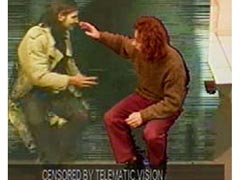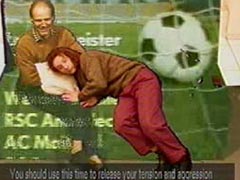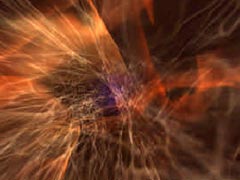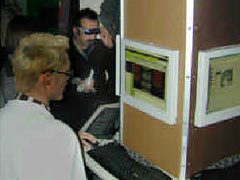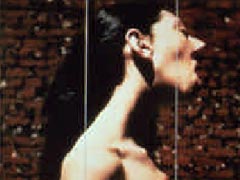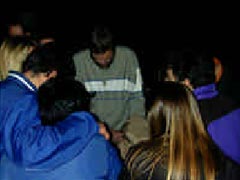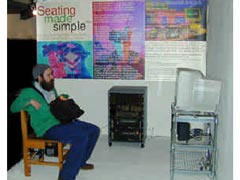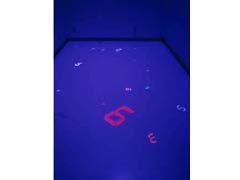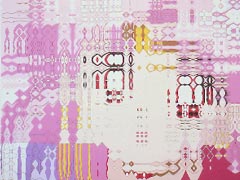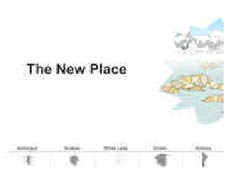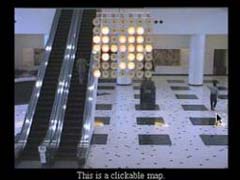| We didn't have to go
far into the new millennium before the art world took some major notice
of high technology. In February and March of this year, three important
exhibitions dealing with the implications of digital technology just
may crack paradigmatic prejudices against plugged-in forms and subjects.
The shows, Telematic Connections: The Virtual Embrace which debuted
at the San Francisco Art Institute and then travels, the San Francisco
Museum of Modern Art's 010101: Art in Technological Times, and BitStreams
at the Whitney Museum of American Art, each employ a very different
look at their subjects. But the fact that they appear simultaneously
suggests there's some cultural common ground. What follows is an online
dialog with three curators involved with these concurrent exhibitions. [ed., SFAI, Feb. 2001]
Steve Dietz is Director of New Media Initiatives at the Walker Art Center in Minneapolis and curator of Telematic Connections, Lawrence Rinder is the Whitney's Anne & Joel Ehrenkranz Curator of Contemporary Art and co-curator of BitStreams, and Benjamin Weil, SFMOMA's Curator of Media Arts, is one of the six interdisciplinary curators of 010101. The conversation was lead by Bay Area writer Glen Helfand. (For exhibition dates and URLs, please see the end of the document.) Glen Helfand: It seems as if this is a touchstone moment when major institutions are giving a seal of approval to art related to the digital and various forms of high tech, allowing them into main galleries rather than new media corners. Your exhibitions also chart the increasing art world realization that tech-related work doesn't solely exist on the computer screen, it can also play out in actual space. What have been the developments and projects that have laid the groundwork for this idea? How do you position your exhibitions historically? Steve Dietz: While the press likes to frame, say, the inclusion of net art in the 2000 Whitney Biennial as a "seal-of-approval" event, I would argue that it's fundamentally an artistic choice, not a museological or curatorial one. Historically, when the visual arts departments of major museums began collecting photography-based work, it wasn't because they woke up one morning and decided that Cindy Sherman could hang next to--or at least near--Francis Bacon; Sherman did. For various reasons--including monetary, I'm sure she and her contemporaries felt that "visual arts" was a more appropriate context for what they were trying to do than "photography." It was the job of museums and curators to critically respond to this positioning. In a similar way, many artists are now working with "technology" and the networks for concrete and varied reasons. It is incumbent on those of us working with institutions committed to the contemporary to investigate an intersection. One of those intersections for Telematic Connections is precisely physical installations for which the global communications network is a critical component. One of the things I found out in researching the Telematics Timeline, which is intended as an open source context for the works in the exhibition--anyone can add their own examples to it is that there is a well-articulated, if not well-known history of such works and events. Whether it is Myron Krueger's "responsive environments" from the 70s in relation to Victoria Vesna's Community of People with No Time or Joseph Weizenbaum's Eliza (1966) in relation to Maciej Wisniewski's Netomatheque or Kit Galloway and Sherrie Rabinowitz's Satellite Arts Project (1979) in relation to Paul Sermon's Telematic Vision, there are important precedents for almost every work in the exhibition. Precedents, I should add, by artists who continue to produce work actively, although often outside of the orbit of mainstream art institutions. Lawrence Rinder: BitStreams is concerned specifically with art that has been made with digital means and which reflects thematically on life in the digital age. Thus, it is not simply a milestone in the history of "tech-art" exhibitions--which go back several decades, if not more--but, rather, a focused investigation of a newly ubiquitous mode of imaging, communication, and production that has had a revolutionary impact on both the art world and society at large. The 1999 exhibition "Net_Condition" at ZKM (which Benjamin worked on if I'm not mistaken) might be a considered a kind of precedent insofar as it focused on the impact on art and society of a particular set of technologies. However, BitStreams takes a broader view of digital practice than did "Net_Condition." Although digital media a re by definition "high-tech," their artistic products are not necessarily so: as evident in BitStreams, artists are using digital media to create works that possess strong physical, even visceral presences. Rather than seeing BitStreams as a "seal of approval," I'd vastly prefer that people experienced it simply as an opportunity to expand their knowledge of an important new direction in contemporary art and, specifically, to become aware of the incredible new modes of expression made possible by digital media. Benjamin Weil: In regards to history, I tend to think there a re two directions that have informed the selecting process for 010101. This said, I cannot speak for my colleagues, and will make sure that I only reflect what my position is here. There's a consensus that has resulted in this exhibition, which I am happy to say is the result of shared interests and concerns. I would say that there's a form a list approach and a more conceptual one. To a certain extent, what interests me in the formal approach, is how the notion of painting‚or sculpture‚can be carried out not only with traditional materials (i.e. oil or acrylic, or whatever) on a flat surface we could call canvas, but also in the digital realm. Interestingly enough, someone compared Mark Napier's Fee to an abstract expressionist painting generator! That denotes our interest in linking back to the past, even if at times, this may appear as a far-fetched comparison. In fact, Mark Napier's work is much more related to conceptual art than to any formalist idea or approach to art! However, I think that this idea of linking back to earlier art forms is important, because 010101 is not a show about technology (I do not believe any of the three shows we are referring to is, or at least, I hope not.) Therefore it is essential to juxtapose the work of artists being carried out in analog media and the ones carried out with digital tools, be they digital "paintbrushes" or "chisels" or more software-based, more conceptual ones. Because the boundaries are not that easy to establish, there's photography, which lies half way in between, in the case of someone like [photographer] Andreas Gursky, who has been using computers to "finish" his work. Char Davies' work may be immersive, it is also about surface, it is also about lusciousness, and all these qualities I find very painterly. The second premise in my opinion is more stemming out of conceptual art, and that means that form is less important, if only because it may be evolving. What we are gradually learning from unstable media is that form may not be as important as content, which in turn carries out intent. That's where online work may be most evidently paced, at least the selection we offer as part of the 010101 show... although of course, some may say the work of Entropy8Zuper! may be more "painterly"! I think that what is important with 010101 is that it is an exhibition that acknowledges the formidable challenges that the collecting and cultural disseminating institution has to face. Museums as we know them are monuments to culture, as well as monuments FOR culture. However the current state of culture is not interested in monumentalization. It was interesting all of a sudden to see a candy piece by Felix Gonzalez-Torres at MOMA in an exhibition with other woks of art produced in different times of the "modern" era. The piece somehow manages to avoid consecration, because it is desecrated by being a space of partaking. I don't know how to express it better, but I was really amazed at how this still functioned, 10 years later, with less of an insider's feeling. It has become a public work, and yet, it still managed to retain its extraordinary inherent quality. What I am trying to say here, is that there is a type of art that demands other museological practice, more humbling presentations, which in turn makes the art idea more accessible. In the case of 010101 (and I believe the other two shows as well), we're trying to understand what it means for art to be dissociated from its material qualities. That is mainly brought by the fact art forms of today will not have a defined existence, formally speaking. With digital media the immediacy of formal obsolescence is even more crudely posed. And maybe that aspect of things is important to look into, when it comes to understanding what it means to be a museum, and what it means to be a curator today. What is also important here, is to realize that art is what is important: not how it is made, or what it is made of. Maybe we are finally coming to terms with the fact that art may not necessarily be justified by the beautiful craftsmanship. Compelling concepts and ideas well conveyed may be an acceptable level of acceptance for art proposals! Maybe technology has consecrated that will to be freed from the mastery of a craft artists have been craving for since Duchamp--if not before! We have not yet found a way to tackle the issue of how to include art forms that historically were informed by technology. I think here of artists who have pioneered technological forms, but who's relationship to technology is very hard to decipher inside the traditional canons of the art world. I'm thinking of artists such as Simon Penny or Perry Hoberman, Michael Naimark or Jeffrey Shaw, or Lynn Hershmann, and so many others. I think there's a lot of thought that needs to be given to those investigations, how to re-integrate them within the continuum of "Art" . This may be because these works maintained a more "scientific" relationship to technology... This is a really difficult issue, I think. But we need to sort out a way to be more inclusive of these works in the future... GH: How did you go about developing and focusing your exhibition (and breaking it into thematic sections) in a climate awash in vast, hyperbolic discussions of digital technology and its economic and social impact? How much of that cultural phenomenon is addressed within your exhibition? LR: I developed BitStreams by first looking at as much work made with digital media as I could. I quickly became aware that digital media have become virtually ubiquitous in the field of contemporary art. Just about every gallery I went in to had at least one, if not more, artists utilizing digital media to some degree in their work. Not only young artists who have grown up in the digital age and for whom it seems to be second nature, but also older, established artists who have turned to these technologies for various purposes. In order to focus the project, I decided that there should be dual criteria for the exhibition: a.) works made using digital technology and b.) works reflecting thematically on digital effects or the experience of life in the digital age. I did not feel that it would be advantageous to further categorize the works included in the exhibition insofar as it might artificially limit people's readings of what are phenomenally multi-dimensional works. However, I did try to install the exhibition in such a way that relationships among groups of works might become more evident. SD: Part of my goal was to get past the idea of the survey. Just as it seems nonsensical at this point to do an exhibition of "painting" or "photography," I think that artists' practice is well beyond "computers and art" or "net art" as useful intersections for their work. I was interested in two more limited intersections: physical interfaces to the network and utopian versus dystopic notions of how the convergence of computing and communications (telematics) brings us closer together--or doesn't. The desire to "connect" is fundamental to being human, but what is the status of the virtual embrace more than a century after the invention of "tele-technologies" such as the telegraph and the telephone? At the same time, this work does not happen in a vacuum, and in "Tele-wood" I present clips from a series of Hollywood films about this desire to connect across space and time, from "Beam me up," to the "integrator/disintegrator" in The Fly (1958) to telepathic communication in a laughably bad Flash Gordon (1980). While Tele-wood is intended as light-hearted, I think it is difficult to underestimate the influence of past media-ized notions of the future as the cultural fish tank in which we swim. BW: I think that cultural climate at large is important to consider as a decisive factor. Maybe it would not have been that easy for "established" institutions to venture into such complicated exhibition that literally questions the very structure of their operation and poses very complicated problems in terms of organization. The need to keep up with a fast evolving culturescape is certainly a decisive factor in putting together these exhibitions. The museum has an amazing opportunity to address issues that will enable the institution to adapt to new art forms, and a new cultural context. Perhaps it's time to put forward a third way between the good old elitist approach to things and the "societe du spectacle" way of dealing with things: there's got to be a way to think beyond the dictatorship of the focus group that somehow fascinates the non-profit world, and the ivory tower approach, that has somehow been at the core of a traditional curatorial practice. Possibly, this is what these shows really are about! At least I know that partly informs 010101 (if not only my contribution to it!). The museum has to continue being a space of cultural investigation and discovery. It need not be the "discovery channel", though! GH: Interestingly, there's not much crossover in terms of artists in the exhibitions, and there are a number of young or lesser-known names included in the rosters. Clearly this is a very viable, active arena. In considering works, what kinds of themes and aesthetic strains did you notice? Did you encounter types of work that surprised you? BW: For me, there 's been a lot of discovery, not only through my own scouting, but through that of my colleagues. I think that we sometimes tend to operate in very small circuits, and opening up the field is an important part of our endeavor, to learn from each other's discoveries and initiate a dialogue between ourselves as curators. However, I think we need to avoid putting together exhibitions that look like the treasure trove from a trip to the unknown lands. That would be what a colleague of mine once called very rightly "The Dangers of Tourism". This said, exhibitions that are exploring the changes brought by technology in the practice of art (understood at large here), and the consequent evolution of museology will require some scouting, and consequently an opportunity to display new works by lesser known artists, architects, designers, etc. We cross paths. This is exciting, it means we have a certain sense of consensus; a common set of beliefs and interests. Maybe we are in the process of articulating a critical discourse more suited to new art forms... On the other hand, we do have different approaches. I think‚from what I know ‚that the three shows we are talking about are informed by different understandings, or rather, complementary interests. I also think it is important to reiterate here that 010101, contrary to the two other shows, is curated by more than one person, five curators from various departments ranging from painting and sculpture to media arts, design and architecture, to education. Our scope of interest is consequently wider, and addresses other issues, such as how to define art as a specific area of cultural investigation. I have been talking about R&D [Research and Development], which seems to irritate a few people. However, I think to use "cultural R&D" is interesting as a premise, as it enables us to go beyond the boundaries of "Art", and reach out to practices that are equally challenging, if only in different ways. Not so long ago, when I visited the Exploratorium with a gallerist, he smiled and said he thought that some of the exhibits were better than a lot of art we see in galleries these days. Beyond the evident sarcasm, I think that maybe what was being implied is that art and science are not far removed, and that "fundamental research" in the sphere of culture should be as acceptable as in the sphere of science. SD: It didn't surprise me that many artists are actively working with non-WIMP (Windows, Icons, Menus and Pointing devices) interfaces to the virtual world of the networks, who were not interested in positioning their work's thematic as "techno." But I was excited to more fully discover the really rich discourse and activity that preceded these efforts. When you re-read Gene Youngblood's Expanded Cinema, you realize how prescient he was about what the Internet, some 20+ years later, has allowed to penetrate cultural consciousness at a much broader level. But he was not a lone voice. There was a lot of significant activity and theorizing going on that was simultaneously more techno-fetishistic because there was not a ubiquitous network--technology had not become like electricity--and more generalized around the idea of communication because there wasn't such a convergence on a single protocol, like the World Wide Web. The theory had to work cross-platform, so to speak, whether you were using a fax machine or a telephone or a computer. LR: There were several "strains" of work that emerged as I selected works for the exhibition. Some artists, such as Michael Rees and Craig Kalpakjian, explore the realm of virtual reality, creating bizarre images and objects that are entirely constructed by means of software programs and yet which possess an uncanny degree of verisimilitude. Another large group is concerned with the ways that digital media can transform pre-existing images, challenging our notions of objective truth and of originality. Paul Pfeiffer, Warren Neidich, Lynn Marie Kirby, Lutz Bacher, Jon Haddock, and Carl Fudge are all exploring this provocative terrain. John Klima and Lew Baldwin as well as all the artists included in Christiane Paul's exhibition Data Dynamics (which will be on view simultaneously with BitStreams at the Whitney) are engaged with ways that physical movement and information flow can be "mapped," that is represented graphically and dynamically in real time. This group of artists benefits especially from the unique capacities of the Internet to carry streaming data from all corners of the world. Many artists use digital media as an intermediate stage in creating a final work that is often fabricated by hand using traditional artmaking methods. Carl Fudge, for example, digitally developed the composition of his print series, Rhapsody Spray, but made the final piece with a painstaking silkscreen process. Similarly, Robert Lazzarini, uses three-dimensional modeling programs to create the compound distortions in his skulls, but the sculptures themselves are meticulously honeymooned of solid bone. While works such as these remind us of how our perceptions of form, color, space, and time have been transformed by digital technology, a number of artists comment overtly on the experience of life in the digital age. Jeremy Blake's five-channel animation, Jim Campbell's ethereal LEDs, and Leah Gilliam's graveyard of outmoded Macs all raise disquieting emotions concerning our race towards a cybernetic future . GH: Can you point to any specific pieces that most succinctly address themes in your exhibition? SD: No. I would expect that each work complicates and escapes to some extent my curatorial vantage point. Tina LaPorta's Re:mote_corp@REALities, perhaps because it is edited as a linear video, is very pointed about the thematics of distance and (dis)connection. But it is important to experience the visceral virtual embrace of these projects. Do you like it? BW: No. I think the show is a mosaic that is well balanced. Each work has its own value in the making of an overall curatorial statement about what we collectively believe is a possible snapshot of the current state of things. 010101 is a show that is deliberately global (as much as some may say there 's a serious lack of African representatives!), and as deliberately trying to circumvent the notion of media as a determining factor for a show about technology. There are web sites, "VR" installations, video projections, "physiological architecture", photography, designed environments, installations, drawing, painting, and sculpture (the three latter terms here referring to more "traditional" art forms). Just as an example of interesting crossovers, that denote artists increasingly working across‚beyond?‚media, I like the fact, that an artist understood as a painter ‚ Matthew Ritchie‚participated in this show with an online contribution. Maybe that epitomizes the interest we have as a group of curators, to cut across our various "disciplines" to find a common ground of operation so as to really try and address the current state of the culturescape. To go back to the issue of trend. I think that this echoes the first question you ask, Glen. Painting, for instance, is no longer limited to the canvas. For instance, the work of an artist like Paul Pfeiffer, is‚in my opinion‚very much informed by painting. What is more interesting in the case of 010101 is how certain trends emerge of the final checklist that may not have been evident beforehand. Take, for instance, the issue of immersion, or immersive experience. Char Davies posited her work that way. However, I completely believe the work of Miyajima falls into this category, and so does the work of Rodney Graham, so does Brian Eno ... and the work of Decosterd & Rahm as well; not to mention the work of Jeremy Blake. So what is immersive? How does a work captivate our intelligence, our sensitivity? How does it engage our body in the experience of it? GH: In organizing the project, did you consider the need to seduce or convince audiences more attuned to conventional media that the work is valid and/or beautiful? Do you feel the public is well versed enough through daily computer use for the works to make sense right off the bat? For certain works where technology is an integral issue, how much do you feel should be spelled out in wall labels? SD: This is a tough one. Of course, it's important to set up the exhibition in a way that will make sense to the visitor and, I believe, give them multiple and varied "hooks" on which to hang their interest. At the same time, I think it's important not to fall into the trap of trying to convince people that such and such a piece is "as good as" something they already know. I think part of the point is to encourage people to explore beyond what they are comfortable with. And I'm also completely confident that many, many visitors will actively enjoy the engagement of interactive works, even though, like any stimulating work of art, it will take some effort to make one's peace with the work, so to speak. BW: I think that, despite "direct" curatorial contribution (selecting artists and projects for the exhibition), the contribution of John Weber, SFMOMA's Curator of Education, has been seminal, in that he's been equally interested (and focusing the interest of the group) in how to create layers of interpretative material to foster interest and curiosity from audiences. The exhibition will have extended labels, and there will be a stream of "think texts" that will foster various thought processes while walking through the gallery part of the exhibition. As a pendant to this, I think of the "sitestreaming" experiment as being a really interesting one: it is the first time there will be an attempt to think about how online art can be framed without necessarily killing the opportunity to discover the work through a more direct access. Along with the artist statements and notes that compliment curatorial interpretations, there is a sum of possible filters to understand the work that are readily available, both online and in the gallery. Layering information is, I think, a very important point in that experiment. Needless to say, showing new art forms calls for a thorough reassessment of museological practice. LR: I did not feel that anything was needed to make the exhibition more seductive. As it is, the works in BitStreams a re extremely sensual and often quite physical. I think that the relatively familiar forms of many of the works may put the audience at ease and allow them to appreciate some of the more subtle transformations taking place in digitally-produced works. In part because the role of digital technology may not be immediately evident in some of the pieces, we decided to produce didactic labels for each and every artist explaining in simple terms how their works were made. GH: From a visual standpoint, will your exhibition be a challenge to conventional museum display? Does it expand the notion of art experience with increased numbers of immersive environments and sound projects? What kind of installation issues do these raise? BW: Intrinsically, it has to. There are a lot of issues that very much challenge the way the installation of an exhibition takes place. Issues of access, labeling, presentation, sound bleed, traffic flow, etc. are raised. They call for a new way to think about our work, and the way we create a perception of the museum as being a space of experiment. Again, it is not about competing with the more leisure-oriented types of activities. Rather, it is about possibly reflecting upon how we can incorporate live culture without immediately turning it into something inert! I think that the think texts will be an interesting test, as will be the experiment at exhibition design, carried out both online and offline, by a team of architects who have made very bold statements. Maybe that will be perceived as the boldest move or maybe it will be a complete failure. But the fact is that we need to try to see how we can evolve the antiseptic, well lit white cube model, which is as constraining as 19th century velvet walls and curio cabinet-like presentations! LR: Probably the most unfamiliar component of BitStreams, for the average visitor, will be the large and central presence of sound art. Over the past few years, sound art has become a key element of the contemporary art scene, though not much recognized at larger museums and arts institutions. Sound artists, in particular, have been tremendously impacted by digital technology. Thus, half of the artists in BitStreams work exclusively with sound. Their works were selected by the exhibition co-curator Debra Singer and installed in a specially designed listening space designed by the great New York-based architecture firm, LOT/EK. SD: The first museum to use a computer in an exhibition was the Jewish Museum for Jack Burnham's Software in 1970. A team of DEC engineers was engaged to set up a PDP--an early time-share computer--to run some of the works, such as Hans Haacke's Visitor Profile and Ted Nelson's Interactive Catalog. It wasn't working at the opening and apparently was often "down" during the exhibition. In some senses, the presentation of computer-based art has been trying to solve that problem ever since. Because Telematic Connections will travel to other sites, Independent Curators International (ICI--the exhibition organizer--has put a lot of effort into creating an infrastructure that is both robust and portable. But it has involved whole new categories of personnel that don't fit conveniently into conventional exhibition functions such as registrar or preparatory. In terms of the visual look of the installations, I don't think that's a particular issue. Every contemporary exhibition has plenty of "weird" stuff these days. But there is potentially a participation problem. Most of the works in Telematic Connections don't "do" anything. Paul Sermon's couches are just that until they are activated by visitors sitting down on each one and interacting with each other--turning into participants rather than viewers. Of course, this is also a virtue. I've seen--and participated in--many installations where it's hard to get people to leave, they are so engaged by the work. GH: Each of your exhibitions has an accompanying website and/or web project section. How did you develop this a rea? How does it differ from the gallery component? Does the opportunity to present a larger amount of contextual information--essays, related projects, biographies, etc.--have any impact on the curatorial process? Do you feel it allows you to engage with more complex ideas than a traditional gallery exhibition? SD: In the past, I have primarily curated exhibitions that are only online, so it's been interesting to adjust to the idea, say, of a fixed, delimited text that goes up on the walls--or that the walls are fixed and delimited for that matter. The tension is that I don't see the website, which I collaborated with Carl DiSalvo, as "just" a reflection of the physical exhibition. It's like Englebart's idea of human intelligence augmentation. The symbiosis of physical and virtual installations is a complex system, which feeds on itself to allow possibilities that cannot be achieved in either dimension alone. LR: The BitStreams web site was developed by Nettmedia, a web design firm noted for their work with David Bowie and the Lilith Fair. We envision it as an online catalog that will enable us to present kinds of information that our audience would not have access to in a printed publication. We plan to include, for example, numerous sound and video clips, interviews with selected artists, and links to related sites. We did not want to fill the galleries with lots of high-tech educational gadgetry and so the website was a perfect vehicle for these kinds of materials. BW: In the past couple of years, the web has become an integral part of our cultural environment, for better or for worse. It has permeated a very large part of our daily lives, and profoundly modified our relationship to time, to services, and of course to control and access to information. This sounds like a really obvious thing, right? However, as we ponder on the way the world has changed in the past couple of years, it is undeniable that the contribution of the web (and the online realm at large) is phenomenal. So how would it be possible to reflect upon the state of culture today, and not include a web component to this endeavor? In the case of 010101, there are two distinct yet related aspect to the online part of the show: one is the documentary part, the other is the "exhibition space" part. I put this between quotation marks, because I do not necessarily think that the metaphor of the gallery is an applicable one to the online medium, which is more time-based, and fluid. Is the web site a stage? Maybe... I think we still need to think more about how to understand this environment, rather than hastily try to apply models we know in order to feel more comfortable with a cultural sphere that is totally amorphous and constantly evolving. The second part is the various layers of information that may be applied to the art experience. I think it is important to point out that the premise here is a one of proposal and experiment. We cannot claim a solution. Rather, we investigate in real time. This is NOT about affirmation. Maybe that is linking back to what the original intent of the museum of modern art is about. As we are entering the 21st century, we are faced with all these issues. What is a museum of modern art? How do we reflect upon cultural evolution? How do we adapt to the ever-changing nature of contemporary art practice? Again, I think that the will to provide tools for interpretation without imposing one and only way of looking at the work on display is a very important and conscious aspect of the 010101 curatorial strategy. It will hopefully be understood as such. Mapping, offering different trajectories, a set of information and interpretation layers is what new technology has fostered. It will also, hopefully, engage various audiences in a new fashion. 010101: Art in Technological Times BitStreams Telematic Connections: The Virtual Embrace |

